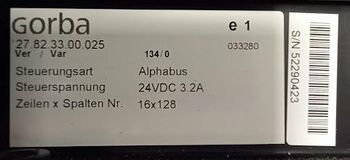GorbaDisplay: Difference between revisions
| Line 112: | Line 112: | ||
== Software == | == Software == | ||
Repository: https://github.com/bertrik/GorbaDisplay | |||
Revision as of 23:37, 8 August 2023
| Project GorbaDisplay | |
|---|---|

| |
| Public transport LED display | |
| Status | Initializing |
| Contact | bertrik, User:Eloy |
| Last Update | 2023-08-08 |
Introduction
This project is about reverse engineering a former public transport LED display. It consists of Z panels of each X * 16 LEDs. Each panel has 16 amber LEDs vertically.
The plan is to make the display fully addressable as a bitmap display over a network connection, preferably with individually controllable brightness per pixel.
TODO:
- more reverse engineering by tracing out the connector to the individual lines of the integrated circuits -> mostly done now
- is there a separate power supply line to the board? if so, can we power our new microcontroller from the 14-pin connector? -> NO appears to be only 2.2V!
- measure clock frequencies (column clock, line update frequency) of original controller board
- write software to control this thing, e.g. for ESP8266
- investigate https://github.com/qisun1/ESP8266_LED_64x16_Matrix , seems to be a similar display
Hardware

This thing consists of two main parts:
- a control board, with logic to receive (for example) text messages over a serial connection and convert them to a bitmap display on the display board
- a display board, with logic to light up each LED, consisting of 4 panels of 16x16 LEDs each
It has a light sensor to sense the ambient light level.
Each panel appears to work almost independently: it has its own power supply circuit, receiving input through a 14-pin connector and forwarding data to the next panel using another 14-pin connector. Each panel receives 24V and contains an LM2678 chip, also known as the Texas instruments "simple switcher", to drop the voltage down to approximately 2.2V.
Each display panel contains the following integrated cicruits:
- 74HC541, an octal buffer/line driver, buffers most of the signals coming in from the 14-pin connector to the rest of the electronics on the panel
- 74HC238, a 3-to-8 line decoder/demultiplexer, probably selects which row is currently being lit up
- group of 4x IRF7425, power MOSFET, probably for driving a 1-out-of-4 row of LEDs
- a whole bunch of TPIC6C596, 8-bit shift register, probably drives the columns inside one row of LEDs
Each LED has a 10 ohm resistor in series. LEDs are amber/orange.
Theory of operation
This is probably a row-multiplexed display.
Each 32x16 panel contains 512 LEDs and 16x8-bit shift registers. Multiplexing is therefore probably 1-in-4.
A panel can light up four rows at a time. By quickly lighting up each row in succession, the illusion to a human observer is that all LEDs are controlled simultaneously.
column demultiplexer
The demultiplexer is capable of handling 3 bits, enough for 8 rows.
row registers
Each panel contains 32x16 pixels. It has a shift register consisting of 16 TPIC6C596 circuits organised in 4 rows of each 32 pixels. The shift registers of one panel are wired up in series. At the end of the shift register chain of each panel, there is another 596 chip, the output feeds into the data pin of the output 14-pin connector.
Possibly one out of four rows can be lit at a time this way.
14-pin connector
My guess for the pinout so far is:
| Pin | Id | Remark |
|---|---|---|
| 1 | GND | Ground |
| 2 | GND | Ground |
| 3 | ROW_SEL0 | 74HCT541:A3-Y3 -> 74HCT238:A0 |
| 4 | ROW_SEL1 | 74HCT541:A2-Y2 -> 74HCT238:A1 |
| 5 | ROW_SEL2 | 74HCT541:A1-Y1 -> 74HCT238:A2 |
| 6 | ? | 74HCT541:A0-Y0 -> ? |
| 7 | ? | |
| 8 | ? | |
| 9 | COL_DATA | 596:SER_IN |
| 10 | COL_ENABLE | 74HCT541:A4-Y4 -> 596:G |
| 11 | COL_CLOCK | 74HCT541:A5-Y5 -> 596:SRCK |
| 12 | COL_LATCH | 75HCT541:A6-Y6 -> 596:RCK |
| 13 | VCC | Power, about 2.2V |
| 14 | VCC | Power |
There are possibly pins for:
- row select, bit 0
- row select, bit 1
- row select, bit 2
- row select, bit 3
- row-enable
- shift register data
- shift-register clear
- shift-register data
- analog LDR value
- remote control input
- power pin
- ground pin
Software
Repository: https://github.com/bertrik/GorbaDisplay